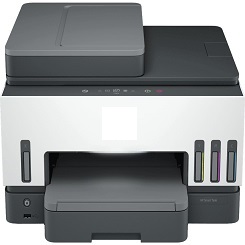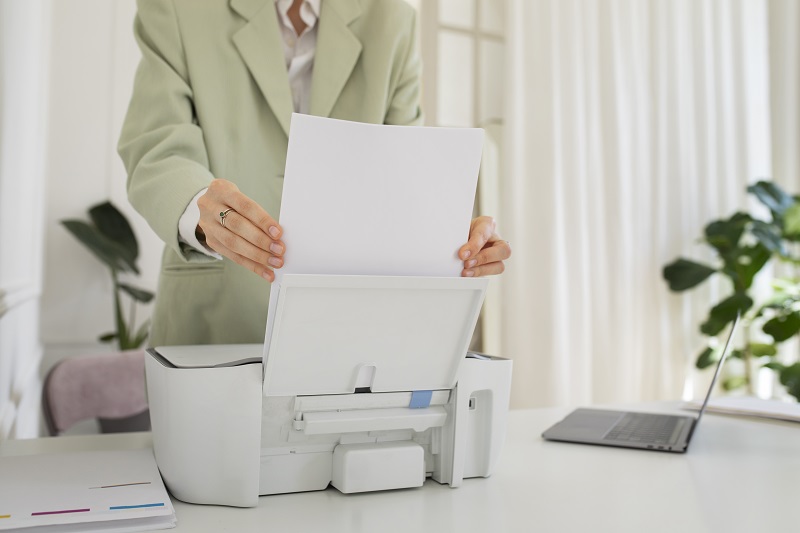PRINTER CONNECT

Download Printer Drivers
Examples of where to find your product name



Paper jams are a common frustration for printer users, but understanding their causes can help prevent and resolve these issues more effectively. Several factors contribute to paper jams, including improper paper loading, using incorrect paper types, and mechanical problems within the printer.
One of the primary causes of paper jams is incorrect paper loading. Ensure that paper is properly aligned in the tray and not overfilled. Using the right paper type is also crucial; always refer to your printer's manual for recommended paper weights and sizes.
Printer maintenance plays a significant role in preventing paper feed issues. Regularly clean the paper feed rollers and check for any debris or foreign objects that may obstruct the paper path. Additionally, keep your printer's firmware up to date, as manufacturers often release updates to improve paper handling.
Printer maintenance plays a significant role in preventing paper feed issues. Regularly clean the paper feed rollers and check for any debris or foreign objects that may obstruct the paper path. Additionally, keep your printer's firmware up to date, as manufacturers often release updates to improve paper handling.
When a paper jam occurs, it's essential to clear it carefully to avoid damaging the printer. Always consult your printer's manual for specific instructions on clearing paper jams, as the process may vary between models. Gently remove the jammed paper, being careful not to tear it and leave fragments inside the printer.
To prevent future paper jams, store paper in a cool, dry place to avoid moisture absorption, which can affect paper feeding. Regularly inspect your printer for signs of wear and tear, and consider professional servicing if paper jams persist despite following best practices.




Slow printing with Wi-Fi printers can be a frustrating experience, but there are several ways to boost your print speed and improve overall performance. One of the primary factors affecting print speed is network connectivity. Ensure your printer is receiving a strong Wi-Fi signal by placing it closer to your router or using a Wi-Fi extender. Additionally, consider switching to a less congested Wi-Fi channel to reduce interference.
Printer optimization plays a crucial role in enhancing speed. Regularly update your printer's firmware and drivers to benefit from the latest improvements and bug fixes. Adjusting print quality settings can also make a significant difference; lower quality settings often result in faster printing times for documents that don't require high resolution.
Effective print queue management is essential for maintaining smooth printing operations. Clear out any stuck print jobs that may be clogging the queue, and consider setting up your printer to delete print jobs automatically after completion. For large print jobs, try splitting them into smaller batches to prevent overwhelming the printer's memory.
Lastly, if you're still experiencing slow printing speeds, consider using a wired connection instead of Wi-Fi. A direct Ethernet connection can provide more stable and faster data transfer, potentially resolving persistent speed issues with your Wi-Fi printer.
Addressing poor print quality issues can significantly enhance your printing experience. One of the first steps to take is cleaning the print head, which can become clogged with dried ink over time. Most printers have a built-in cleaning function, but you can also manually clean the print head using specialized cleaning solutions.
Ink cartridge issues are another common cause of subpar prints. Ensure your cartridges are properly installed and not running low on ink. Some printers may produce poor quality prints when using non-genuine or refilled cartridges, so consider using manufacturer-recommended ink for optimal results.

Printer calibration plays a crucial role in print quality. Many printers offer automatic calibration tools, but you can also perform manual calibration to fine-tune color accuracy and alignment. This process helps ensure that colors are vibrant and text is crisp.
Optimizing print settings can make a significant difference. Adjust the print quality settings in your printer software, selecting the appropriate paper type and print resolution for your project. Higher quality settings may take longer to print but often yield superior results. By implementing these tips and tricks, you can troubleshoot and improve poor print quality, resulting in professional-looking documents and images from your printer.
Resolving printer driver problems is essential for maintaining smooth printing operations. Driver installation issues often arise when setting up a new printer or after a system update. To address this, ensure you're downloading the correct driver for your specific printer model and operating system version. Many manufacturers offer automated tools to detect and install the appropriate drivers.
Regular driver updates are crucial for optimal performance and security. Set your system to automatically check for updates or periodically visit the manufacturer's website for the latest versions. If you encounter compatibility issues after an update, rolling back to a previous driver version can be a temporary solution.
Troubleshooting drivers may involve uninstalling and reinstalling the software, checking for conflicts with other hardware or software, or running built-in diagnostic tools. In some cases, using generic drivers provided by your operating system can resolve persistent issues.
For complex driver problems, consult your printer's user manual or contact the manufacturer's support team. They can provide specialized guidance and may offer additional troubleshooting steps specific to your printer model.
When your scanner suddenly stops working, it can be frustrating, but there are several steps you can take to troubleshoot and resolve the issue. First, check the physical connections to ensure the scanner is properly plugged in and connected to your computer. If the hardware seems fine, move on to software-related problems. Update or reinstall your scanner drivers, as outdated or corrupted drivers are a common cause of scanner malfunctions. Also, check for any software conflicts by temporarily disabling antivirus programs or firewalls that might be blocking the scanner's operation.
If these steps don't work, try connecting the scanner to a different USB port or computer to rule out port-specific issues. For more complex problems, consult your scanner's manual or the manufacturer's website for model-specific troubleshooting guides. Remember, if you've exhausted all options and the scanner still isn't functioning, it may be time to consider professional repair or replacement.

Unclear printed texts can be a significant hindrance to effective communication and productivity. To address this issue, several factors need to be considered. First, adjusting font settings can greatly improve legibility. Choosing a clear, sans-serif font and increasing the font size can make text more readable, especially for those with visual impairments.
Print resolution plays a crucial role in text clarity. Ensuring your printer is set to the highest quality setting can significantly enhance the sharpness of printed characters. However, it's important to balance this with ink conservation, as higher quality prints typically use more ink.
Ink conservation methods, such as using draft mode for less important documents or switching to eco-friendly fonts, can help maintain clarity while reducing costs. However, for critical documents, it's advisable to prioritize quality over ink savings.
Paper quality is another essential factor. Using high-quality, smooth paper can prevent ink from bleeding or spreading, resulting in crisper text. Matte finish papers often produce better results than glossy ones for text-heavy documents.
By addressing these key areas - font settings, print resolution, ink usage, and paper quality - you can significantly improve the clarity of your printed texts, ensuring your message is conveyed effectively and professionally.
Duplex printer printing errors can be frustrating, but many common issues have straightforward solutions. First, check your printer driver settings to ensure two-sided printing is enabled and configured correctly. If the settings are correct, examine the paper feed mechanism for any obstructions or damage that might prevent smooth paper movement. Paper quality and weight can also affect duplex printing; use paper specifically recommended for your printer model.
Sometimes, hardware malfunctions can cause duplex printing errors. Check for any visible damage to the duplexing unit and clean the rollers to remove debris that might interfere with paper movement. Updating your printer's firmware can resolve software-related issues that affect two-sided printing performance.

If problems persist, try printing a test page in simplex mode to isolate whether the issue is specific to duplex printing. For recurring errors, consult your printer's manual for model-specific troubleshooting steps or contact the manufacturer's support team for advanced assistance. Regular maintenance and using high-quality supplies can help prevent many duplex printing issues in the long run.

Setting up your printer doesn't have to be a daunting task. Follow this step-by-step guide to get your printer up and running in no time:
1. Unpack and assemble: Carefully remove your printer from its packaging and assemble any necessary components according to the manufacturer's instructions.
2. Connect to power: Plug your printer into a power outlet and turn it on.
3. Install printer drivers: Visit the manufacturer's official website to download and install the latest drivers for your specific printer model and operating system version.
4. Connect to your device: Choose between USB or wireless connection. For USB, simply connect the cable. For wireless, access your printer's network settings and connect it to your Wi-Fi network.
5. Install printer software: Install any additional software that came with your printer or download it from the manufacturer's website.
6. Configure settings: Open your computer's printer settings and ensure the new printer is set as the default device.
7. Test print: Send a test page to your printer to confirm everything is working correctly.
8. Troubleshoot if necessary: If you encounter any issues, consult your printer's manual or the manufacturer's support website for guidance.
By following these steps, you'll have your printer set up and ready to use in no time. Remember to keep your printer's software and drivers updated for optimal performance.
When your printer suddenly goes offline, it can disrupt your workflow and cause frustration. Understanding the common causes and solutions for this issue can help you quickly bring your printer back online. First, check the printer's physical connections, ensuring all cables are securely plugged in and the device is powered on. Next, verify your network connectivity, as weak Wi-Fi signals or disconnected Ethernet cables can cause printers to appear offline.
If the physical connections are intact, examine your printer's status through its control panel or your computer's printer settings. Sometimes, simply restarting both the printer and your computer can resolve connectivity issues. For wireless printers, double-check that they're connected to the correct network and have a strong signal.
Updating printer drivers and firmware can also address persistent offline issues. If problems persist, consult your printer's manual for model-specific troubleshooting steps or contact the manufacturer's support team for advanced assistance. By systematically addressing these potential problems, you can often restore your offline printer to full functionality without the need for professional intervention.

Set up your printer by first connecting it to your computer and then installing the printer driver.

OfficeJet Pro 9025 All-in-One

Smart Tank 670

OfficeJet Pro 9130

DeskJet 2720

ink-tank-Printer

Deskjet printer

laserjet-printer

Deskjet Printer
Copyright © 2024 downloadprinter.com All rights reserved.
